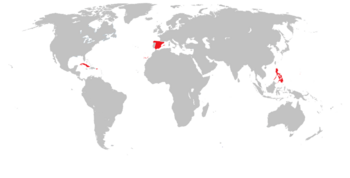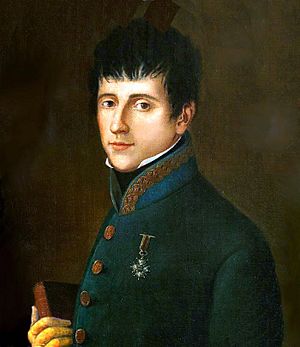Trienio Liberal facts for kids
Quick facts for kids
Kingdom of Spain
España
Reino de España |
|||||||||
|---|---|---|---|---|---|---|---|---|---|
| 1820–1823 | |||||||||
|
Motto: Plus ultra (Latin)
(English: "Further Beyond") |
|||||||||
|
Anthem: Himno de Riego
Anthem of Riego |
|||||||||
 |
|||||||||
| Capital | Madrid | ||||||||
| Common languages | Spanish | ||||||||
| Religion | Roman Catholic Church (official) | ||||||||
| Demonym(s) | Spanish | ||||||||
| Government | Unitary parliamentary semi-constitutional monarchy | ||||||||
| King | |||||||||
|
• 1820–1823
|
Ferdinand VII | ||||||||
| Secretary of State | |||||||||
|
• 1820–1821
|
Evaristo Pérez | ||||||||
|
• 1821–1822
|
Ramón López-Pelegrín | ||||||||
|
• 1822
|
Francisco Martínez | ||||||||
|
• 1822–1823
|
Evaristo Fernández | ||||||||
|
• 1823
|
José María Pando | ||||||||
| Legislature | Cortes Generales | ||||||||
| Historical era | Revolutions during the 1820s | ||||||||
|
• Established
|
1 January 1820 | ||||||||
| 7 March 1820 | |||||||||
|
• First general election
|
April – May 1820 | ||||||||
|
• Second general election
|
October – December 1822 | ||||||||
| 1 October 1823 | |||||||||
| Currency | Escudo, Real | ||||||||
|
|||||||||
| Today part of | |||||||||
The Trienio Liberal (which means "Three Liberal Years" in Spanish) was a time in Spanish history from 1820 to 1823. During this period, a new government ruled Spain. This government was called "liberal" because it wanted more freedom and rights for people.
This change happened after a military uprising in January 1820. A soldier named Rafael de Riego led the revolt against King Ferdinand VII. The King had been ruling with "absolute power," meaning he made all decisions alone. The Trienio Liberal ended in 1823. A French army invaded Spain and gave the King his absolute power back. This event is known as "The Hundred Thousand Sons of St. Louis" in Spain.
The 1820 Revolution in Spain

King Ferdinand VII made many people unhappy. He refused to accept the Spanish Constitution of 1812. This constitution was a set of rules that would give people more rights and limit the King's power.
The King also wanted to take back the Spanish colonies in America. These colonies had recently fought for their independence. Spain needed money from these colonies.
In January 1820, soldiers gathered in Cádiz to prepare for a trip to South America. They were angry because they weren't paid enough, the food was bad, and their living conditions were poor. So, they rebelled under the leadership of Rafael del Riego. They promised to support the 1812 Constitution and took control of their commander.
The rebel soldiers then moved to San Fernando. From there, they planned to march to the capital city, Madrid.
Spain's Liberal Government
Even though the rebels were not very strong, King Ferdinand agreed to the constitution on March 9, 1820. This meant that liberal leaders would now be in charge. This period became known as the Liberal Triennium.
However, there were many secret plans and groups in Spain. Some wanted more freedom, and others wanted the King to have all the power again. Liberal revolutionaries went to the King's palace and took control of Ferdinand VII. For the next three years, he was like a prisoner of the Cortes Generales (Spain's parliament).
In 1822, new elections for the Cortes Generales were held. Rafael del Riego won these elections. But the King's supporters gathered in Urgell. They started fighting and set up a government that wanted the King to have absolute power again.
The King's supporters, along with the Royal Guard, tried to start a rebellion in Madrid. But forces supporting the new liberal government stopped them. Even though the King's supporters lost in Madrid, a civil war began in other parts of Spain. This included areas like Castile, Toledo, and Andalusia.
For three years, the liberal government ruled. They tried to change Spain by dividing it into 52 provinces. They wanted to reduce the power that different regions had. Regions like Aragon, Navarre, and Catalonia did not like these changes. They agreed with the King that the liberal government was bad.
The liberal government also made changes that upset the Catholic Church. They tried to make Spain more industrial, which upset old trade guilds. The Spanish Inquisition, a powerful religious court, had been stopped before. The liberal government ended it again. This led some people to accuse the government of being too much like the French.
Some liberals wanted to get rid of the monarchy completely. In 1821, their attempt to rebel was stopped. But this showed how fragile the government was.
In 1823, a more radical liberal government was elected. This made Spain even more unstable. The army, which had helped the liberals gain power, started to lose faith. This happened because Spain's economy was not getting better. In 1823, another army rebellion in Madrid had to be stopped.
The Jesuits, a religious group, had been banned before. King Ferdinand VII brought them back, but the liberal government banned them again. During the liberal rule, King Ferdinand lived almost like a prisoner in Madrid.
After the Napoleonic Wars, European countries formed alliances to keep peace. The "Concert of Europe" was worried about Spain's liberal government. They decided to help King Ferdinand.
In 1822, the Congress of Verona allowed France to step in. The French King, Louis XVIII of France, was happy to end Spain's liberal experiment. A huge army, called the Hundred Thousand Sons of Saint Louis, crossed into Spain in April 1823. The Spanish army was divided and did not fight much. The French army quickly took Madrid and put Ferdinand back as an absolute monarch. The hopes of the liberals for a new war of independence were crushed.
The liberal government also tried to negotiate with the American colonies. They offered to stop fighting if the colonies accepted the 1812 Constitution. But the colonies wanted full independence. So, the negotiations failed, and the war continued.
French Army Intervenes

In 1822, King Ferdinand VII asked other European kings for help. He wanted to restore his absolute power. He joined the Holy Alliance, which included Russia, Prussia, Austria, and France. In France, some royalists wanted King Louis XVIII to invade Spain.
The French government first sent troops to the Pyrenees Mountains. These mountains are on the border between France and Spain. Their job was to stop liberal ideas from spreading into France. By September 1822, these troops became a military force ready to invade.
The Holy Alliance (Russia, Austria, and Prussia) did not want to help Ferdinand at first. But the Quintuple Alliance (United Kingdom, France, Russia, Prussia, and Austria) met at the Congress of Verona in October 1822. They gave France permission to invade Spain. Their goal was to bring back the Spanish monarchy.
On January 22, 1823, a secret agreement was signed at the Congress of Verona. This allowed France to invade Spain to make Ferdinand VII an absolute monarch again. With this agreement, on January 28, 1823, Louis XVIII announced his plan. He said that "a hundred thousand Frenchmen are ready to march" to protect the Spanish throne.
See also
 In Spanish: Trienio Liberal para niños
In Spanish: Trienio Liberal para niños





